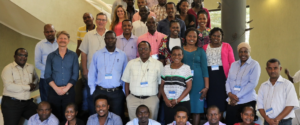Scientific enquiry knows no limits. For every line of research, there’s someone out there who wants to know more. And there are the resources and technologies to back them up.
So when Dr Michael Jennions and his team at the Australian National University wondered if male genital size had any implication on reproductive success, they decided to find out.
Diversity Arrays Technology (DArT) was only too keen to be there to help them.
But first, some background. The study needed a subject that had a short gestation period so that multiple generations could be bred and studied in a relatively short period of time. Enter the mosquitofish (Gambusia holbrooki). Michael describes it as an unattractive little tropical fish that looks like it’s had all its colour leached out of it. It was perfect.
The challenges and complications were understandably many and varied – finding a method for measuring mosquitofish genitalia not least among them. Also, with mosquitofish all equally unattractive, how do you know which pale little fish had been the successful sire of which other pale little fish?
Michael Jennions explains that his request seemed simple: “Really, we just wanted to know which of the fish were related. We supplied DArT with tissue samples, and a week later we had the answer. It couldn’t have been easier.”
DArT started by extracting good quality DNA from the very tiny tissue biopsies supplied, and processed thousands of samples using DArTseq, technology that uses genotyping-by-sequencing.
An enzymatic process is followed by sequencing and data analytics, which are fully integrated with DArT’s laboratory process.
Based on the DNA marker data that was extracted from these sequences, DArT was able to determine very precise genetic relationships among the fish, and link specific males with their progeny.
The volume of data produced had an added benefit. Not only was it sufficient to answer the ‘parentage’ question, it also enabled further exploration of genetic factors underlying both anatomical and behavioural variations in mosquitofish.
Thanks to DArT, the ANU research was able to reach a conclusion – that male genital size does not have any bearing on attractiveness, swimming performance or the ability to produce progeny – in mosquitofish at least. Whether these findings have any validity in any other species is a question for another day.
“But all scientific research is valuable,” explained Michael Jennions. “When we perfect techniques for researching and finding complex data, we have those skills and that expertise ready to apply to any challenge that’s thrown at us. The ability of scientists – some at ANU even – to respond quickly and develop insights, tests and vaccines against COVID-19 is a great case in point.”
The study into genital size is not the only project with which DArT has assisted Dr Jennions’ team. Among other things, they’ve been looking at the effect of inbreeding, age, and the dominance of certain males over others in their ability and effectiveness in successful mating.
With a mission to generate knowledge and insight into building food security and biodiversity around the world, DArT provides affordable genotyping services to researchers as well as farmers, breeders and ecologists.
As DArT founder and director, Andrzej Kilian, put it: “We are constantly fascinated by the work we support with our technologies and services. A number of the services we have executed for Michael’s projects were at the “pure science” end of the spectrum of our DNA work portfolio, involving thousands of species. Such projects complement well our efforts to provide solutions to many issues relating to diversity and food security around the world – particularly for people in poorer and less developed countries.”
DArT is always looking for individuals and organisations who share their values and would like to consider working with or for them. You can contact us here.
Meanwhile, if you’re a mosquitofish, it appears that size does not matter!


